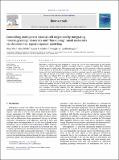| dc.contributor.author | Wu, Shan | |
| dc.contributor.author | Wells, Alan | |
| dc.contributor.author | Griffith, Linda G. | |
| dc.contributor.author | Lauffenburger, Douglas A. | |
| dc.date.accessioned | 2015-03-04T19:41:01Z | |
| dc.date.available | 2015-03-04T19:41:01Z | |
| dc.date.issued | 2011-10 | |
| dc.date.submitted | 2011-06 | |
| dc.identifier.issn | 01429612 | |
| dc.identifier.uri | http://hdl.handle.net/1721.1/95816 | |
| dc.description.abstract | Biomimetic scaffolds have been proposed as a means to facilitate tissue regeneration by multi-potent stromal cells (MSCs). Effective scaffold colonization requires a control of multiple MSC responses including survival, proliferation, differentiation, and migration. As MSC migration is relatively unstudied in this context, we present here a multi-level approach to its understanding and control, integratively tuning cell speed and directional persistence to achieve maximal mean free path (MFP) of migration. This approach employs data-driven computational modeling to ascertain small molecule drug treatments that can enhance MFP on a given materials substratum. Using poly(methyl methacrylate)-graft-poly(ethylene oxide) polymer surfaces tethered with epidermal growth factor (tEGF) and systematically adsorbed with fibronectin, vitronectin, or collagen-I to present hTERT-immortalized human MSCs with growth factor and extracellular matrix cues, we measured cell motility properties along with signaling activities of EGFR, ERK, Akt, and FAK on 19 different substrate conditions. Speed was consistent on collagen/tEGF substrates, but low associated directional persistence limited MFP. Decision tree modeling successfully predicted that ERK inhibition should enhance MFP on collagen/tEGF substrates by increasing persistence. Thus, we demonstrated a two-tiered approach to control MSC migration: materials-based “coarse-graining” complemented by small molecule “fine-tuning”. | en_US |
| dc.description.sponsorship | National Institutes of Health (U.S.) (NIH grant R01-DE019523) | en_US |
| dc.description.sponsorship | National Institutes of Health (U.S.) (NIH Cell Migration Consortium U54-GM064346) | en_US |
| dc.description.sponsorship | National Institutes of Health (U.S.) (NIH grant R01-GM018336) | en_US |
| dc.description.sponsorship | National Institutes of Health (U.S.) (NIH grant R01-DE019523) | en_US |
| dc.language.iso | en_US | |
| dc.publisher | Elsevier B.V. | en_US |
| dc.relation.isversionof | http://dx.doi.org/10.1016/j.biomaterials.2011.06.050 | en_US |
| dc.rights | Creative Commons Attribution | en_US |
| dc.rights.uri | http://creativecommons.org/licenses/by-nc-nd/3.0/ | en_US |
| dc.source | Elsevier | en_US |
| dc.title | Controlling multipotent stromal cell migration by integrating “course-graining” materials and “fine-tuning” small molecules via decision tree signal-response modeling | en_US |
| dc.type | Article | en_US |
| dc.identifier.citation | Wu, Shan, Alan Wells, Linda G. Griffith, and Douglas A. Lauffenburger. “Controlling Multipotent Stromal Cell Migration by Integrating ‘course-Graining’ Materials and ‘fine-Tuning’ Small Molecules via Decision Tree Signal-Response Modeling.” Biomaterials 32, no. 30 (October 2011): 7524–7531. © 2011 Elsevier Ltd. | en_US |
| dc.contributor.department | Massachusetts Institute of Technology. Department of Biological Engineering | en_US |
| dc.contributor.mitauthor | Wu, Shan | en_US |
| dc.contributor.mitauthor | Griffith, Linda G. | en_US |
| dc.contributor.mitauthor | Lauffenburger, Douglas A. | en_US |
| dc.relation.journal | Biomaterials | en_US |
| dc.eprint.version | Final published version | en_US |
| dc.type.uri | http://purl.org/eprint/type/JournalArticle | en_US |
| eprint.status | http://purl.org/eprint/status/PeerReviewed | en_US |
| dspace.orderedauthors | Wu, Shan; Wells, Alan; Griffith, Linda G.; Lauffenburger, Douglas A. | en_US |
| dc.identifier.orcid | https://orcid.org/0000-0002-1801-5548 | |
| mit.license | PUBLISHER_CC | en_US |
| mit.metadata.status | Complete | |
